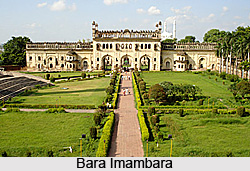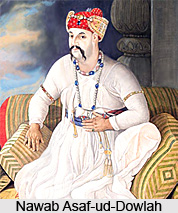 History of Lucknow starts around 1350 AD, when this place was known as Awadh. Lucknow presently is the capital city of Uttar Pradesh and one of the heritage cities in India. Historically, located in Awadh region, Lucknow has always been a multicultural city. Courtly manners, attractive gardens, poetry, music, and fine cuisine patronized by the Persian-loving Shia Nawabs of the city are popular amongst Indians and admirers of South Asian culture and history. Lucknow is popularly known as the City of Nawabs. It is also known as the Golden City of the East, Shiraz-i-Hind and The Constantinople of India.
History of Lucknow starts around 1350 AD, when this place was known as Awadh. Lucknow presently is the capital city of Uttar Pradesh and one of the heritage cities in India. Historically, located in Awadh region, Lucknow has always been a multicultural city. Courtly manners, attractive gardens, poetry, music, and fine cuisine patronized by the Persian-loving Shia Nawabs of the city are popular amongst Indians and admirers of South Asian culture and history. Lucknow is popularly known as the City of Nawabs. It is also known as the Golden City of the East, Shiraz-i-Hind and The Constantinople of India.
The ancient history of Lucknow mentions that after 1350 AD the Lucknow and parts of Awadh region have been under the rule of the Delhi Sultanate, the Mughal Empire, the Nawabs of Awadh, the East India Company and the British Raj. Lucknow was one of the major centers of First War of Independence and participated actively in India`s Independence movement, and after Independence has emerged as a prime city of North India. Until 1719, subah of Awadh was a province of the Mughal Empire that was administered by a Governor selected by the Emperor. Saadat Khan also called Burhan-ul-Mulk a Persian adventurer was chosen as the Nazim of Awadh in 1722 and he established his court in Faizabad near Lucknow.
The region of Awadh was known as the granary of India and was important advantageously for the control of the Doab, the rich plain between the Ganga and the Yamuna rivers. It was an affluent kingdom, able to maintain its independence against pressure from the Marathas, the British and the Afghans. The third Nawab, Shuja-ud-Daula fell out with the British after associating with Mir Qasim, the deserter Nawab of Bengal. He was finally defeated in the Battle of Buxar by the East India Company, after which he was forced to pay heavy penalties and surrender certain parts of his territory. The British selected a resident in 1773, and over the span of time gained control of more territory and authority in the state. They were reluctant to capture Awadh completely, because that would bring them in direct conflict with the Marathas and the remnants of the Mughal Empire.
History of Lucknow states the rise to growth and fame of the city with its elevation as capital of Awadh by Nawab Asaf-Ud-Dowlah. He was a great philanthropist and gave Lucknow a exceptional and enduring heritage. The architectural contributions of these Awadh rulers include several impressive monuments. Of the monuments standing today, the Bara Imambara, the Chhota Imambara, and the Roomi Darwaza are distinguished examples. One of the long-lasting contributions by the Nawabs is the composite culture that has come to be known as the Ganga-Jamuni tehzeeb.
 The medieval history of Lucknow, in 1798, the fifth Nawab Wazir Ali Khan estranged both his people and the British, and was forced to hand over. The British then helped Saadat Ali Khan to achieve the throne. Saadat Ali Khan in the treaty of 1801 ceded half of Awadh to the British East India Company and also agreed to disperse his troops in favor of a hugely expensive, British-run army. This treaty successfully made the state of Awadh a vassal to the British East India Company, though it theoretically continued to be a vital part of the Mughal Empire in name until 1819.
The medieval history of Lucknow, in 1798, the fifth Nawab Wazir Ali Khan estranged both his people and the British, and was forced to hand over. The British then helped Saadat Ali Khan to achieve the throne. Saadat Ali Khan in the treaty of 1801 ceded half of Awadh to the British East India Company and also agreed to disperse his troops in favor of a hugely expensive, British-run army. This treaty successfully made the state of Awadh a vassal to the British East India Company, though it theoretically continued to be a vital part of the Mughal Empire in name until 1819.
The treaty of 1801 was important in the history of Lucknow and formed an arrangement that was very beneficial to the Company. They were able to use Awadh`s vast treasuries, constantly digging into them for loans at reduced rates. The Nawabs were ceremonial kings, busy with lavish lifestyle but with little influence over matters of state. By the mid-nineteenth century, however, the British had grown intolerant with the arrangement and wanted direct control of Awadh. In 1856 the East India Company first moved its troops to the border, then annexed the state, which was placed under a chief commissioner - Sir Henry Lawrence.
The province of Awadh was annexed by the East India Company in 1856 and placed under the control of a chief commissioner. In the Indian Rebellion of 1857, rebel forces besieged the garrison based at the Residency in Lucknow. The famous Siege of Lucknow was relieved first by forces after the decree of Sir Henry Havelock and Sir James Outram, followed by a stronger force under Sir Colin Campbell. Today, the ruins of the Residency, and the picturesque Shaheed Smarak offer reminiscences of Lucknow`s role in the exciting events of 1857.
The history of Lucknow has special mentioning in both the First War of Independence and the modern Indian freedom struggle. Whether it was the Lucknow Pact of 1916 or the Khilafat Movement it brought the Indian citizens on a united platform against the British rule. The history of Lucknow also includes the Khilafat Movement Maulana Abdul Bari of Firangi Mahal, where Lucknow actively participated and cooperated with Mahatama Gandhi and Maulana Muhammad Ali Jauhar, Freedom fighter and one of the greatest parliamentarians, Firoj Gandhi was also related to this city.
The modern history of Lucknow started in 1901, when after staying the capital of Oudh, since 1775, Lucknow, with a population of 264,049, was merged in the newly formed United Provinces of Agra and Oudh. However, Lucknow became the provincial capital in 1920 when the seat of government shifted from Allahabad. Upon Indian independence in 1947, Lucknow became the capital of Uttar Pradesh, the previous United Provinces.



















